Janome Sewist 780DC operation manual

Instruction Book
Sewist 780DC
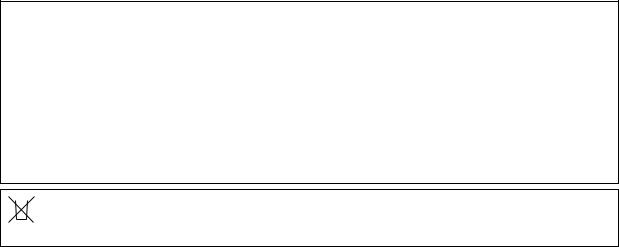
IMPORTANT SAFETY INSTRUCTIONS
When using an electrical appliance, basic safety precautions should always be followed, including the following:
This sewing machine is designed and manufactured for household use only.
Read all instructions before using this sewing machine.
DANGER— To reduce the risk of electric shock:
1.An appliance should never be left unattended when plugged in. Always unplug this sewing machine from the electric outlet immediately after using and before cleaning.
WARNING— To reduce the risk of burns, fire, electric shock, or injury to persons:
1.Do not allow to be used as a toy. Close attention is necessary when this sewing machine is used by or near children.
2.Use this appliance only for its intended use as described in this owner’s manual.
Use only attachments recommended by the manufacturer as contained in this owner’s manual.
3.Never operate this sewing machine if it has a damaged cord or plug, if it is not working properly, if it has been dropped or damaged, or dropped into water.
Return this sewing machine to the nearest authorized dealer or service center for examination, repair, electrical or mechanical adjustment.
4.Never operate the appliance with any air opening blocked. Keep ventilation openings of this sewing machine and foot controller free from accumulation of lint, dust and loose cloth.
5.Never drop or insert any object into any opening.
6.Do not use outdoors.
7.Do not operate where aerosol (spray) products are being used or where oxygen is being administered.
8.To disconnect, turn all controls to the off (“O”) position, then remove plug from outlet.
9.Do not unplug by pulling on cord. To unplug, grasp the plug, not the cord.
10.Keep fingers away from all moving parts. Special care is required around the sewing machine needle and/or cutting blade.
11.Always use the proper needle plate. The wrong plate can cause the needle to break.
12.Do not use bent needles.
13.Do not pull or push fabric while stitching. It may deflect the needle causing it to break.
14.Switch this sewing machine off (“O”) when making any adjustment in the needle area, such as threading the needle, changing the needle, threading the bobbin or changing the presser foot, and the like.
15.Always unplug this sewing machine from the electrical outlet when removing covers, lubricating, or when making any other adjustments mentioned in this owner’s manual.
SAVE THESE INSTRUCTIONS
For Europe only:
This appliance can be used by children aged from 8 years and above and persons with reduced physical, sensory or mental capabilities or lack of experience and knowledge if they have been given supervision or instruction concerning use of the appliance in a safe way and understand the hazards involved. Children shall not play with the appliance. Cleaning and user maintenance shall not be made by children without supervision.
For outside Europe (except U.S.A and Canada):
This appliance is not intended for use by persons (including children) with reduced physical, sensory or mental capabilities, or lack of experience and knowledge, unless they have been given supervision or instruction concerning use of the appliance by a person responsible for their safety.
Children should be supervised to ensure that they do not play with the appliance.
 Please note that on disposal, this product must be safely recycled in accordance with relevant
Please note that on disposal, this product must be safely recycled in accordance with relevant 

 National legislation relating to electrical/electronic products. If in doubt please contact your
National legislation relating to electrical/electronic products. If in doubt please contact your  retailer for guidance. (European Union only)
retailer for guidance. (European Union only)
1
TABLE OF CONTENTS
ESSENTIAL PARTS |
|
Names of Parts............................................................... |
3 |
Standard Accessories.................................................... |
4 |
Stitch Reference Chart................................................... |
5 |
GETTING READY TO SEW |
|
Connecting the Power Supply........................................ |
6 |
Before Using Your Sewing Machine............................... |
6 |
Operating Instructions: ................................................... |
6 |
Controlling Sewing Speed.............................................. |
8 |
Speed control slider ..................................................... |
8 |
Foot control .................................................................. |
8 |
Extension Table.............................................................. |
8 |
Free-arm Sewing............................................................ |
8 |
Machine Operating Buttons....................................... |
9-10 |
Start/Stop button.......................................................... |
9 |
Reverse button ............................................................. |
9 |
Auto-lock button ........................................................... |
9 |
Needle up/down button .............................................. |
10 |
Thread cutter button................................................... |
10 |
LCD Display................................................................... |
11 |
Function Keys................................................................ |
11 |
Arrow key..................................................................... |
11 |
Stitch width adjusting key............................................ |
11 |
Stitch length adjusting key........................................... |
11 |
Thread cutter memory key .......................................... |
11 |
Elongation key............................................................. |
11 |
Direct pattern selection keys ....................................... |
11 |
Selecting Stitch Patterns.............................................. |
12 |
Direct pattern selection .............................................. |
12 |
Presser Foot Lifter........................................................ |
13 |
Changing the Presser Foot .......................................... |
13 |
Removing and Attaching the Foot Holder .................... |
13 |
Presser Foot Pressure Dial .......................................... |
14 |
Adjusting the Needle Thread Tension...................... |
14-15 |
Straight stitch balanced tension................................. |
14 |
Zigzag stitch balanced tension................................... |
15 |
Dropping or Raising the Feed Dog............................... |
16 |
Changing the Needle.................................................... |
17 |
Fabric, Thread and Needle Chart................................. |
17 |
Setting the Spool of Thread ......................................... |
18 |
Bobbin Winding ....................................................... |
18-20 |
Removing the bobbin ................................................. |
18 |
Winding the bobbin .................................................... |
19 |
Inserting the bobbin.................................................... |
20 |
Threading the Machine................................................. |
21 |
Built-in Needle Threader .............................................. |
22 |
Drawing up the Bobbin Thread .................................... |
23 |
Setting Mode................................................................ |
24 |
Buzzer sound setting.................................................. |
24 |
Needle stop position setting....................................... |
25 |
Auto-off timer.............................................................. |
25 |
BASIC SEWING |
|
Straight Stitch Sewing.................................................. |
26 |
Starting to sew............................................................ |
26 |
Securing seams.......................................................... |
26 |
Auto Thread Cutting ................................................... |
27 |
Changing Sewing Direction.......................................... |
27 |
Sewing from the Edge of Thick Fabric ......................... |
27 |
Using Seam Guides ..................................................... |
28 |
Turning Square Corners............................................... |
28 |
Altering the Needle Drop Position ................................ |
29 |
Altering the Stitch Length............................................. |
29 |
Variety of Straight Stitches........................................... |
30 |
Lock-a-matic Stitch..................................................... |
30 |
Locking Stitch............................................................. |
30 |
Triple Stretch Stitch .................................................... |
30 |
Stretch Stitch.............................................................. |
31 |
Sculpture Stitches ...................................................... |
31 |
Zigzag Stitch................................................................. |
32 |
Altering the stitch width .............................................. |
32 |
Altering the stitch length ............................................ |
32 |
Variety of Overcasting Stitches.................................... |
33 |
Overcasting with Zigzag Stitch................................... |
33 |
Multiple Zigzag Stitch................................................. |
33 |
Overedge Stitch.......................................................... |
33 |
Knit Stitch................................................................... |
34 |
Overlock Stitch........................................................... |
34 |
Buttonholes .................................................................. |
35 |
Square Buttonhole................................................. |
36-38 |
Altering the buttonhole width.................................... |
38 |
Altering the buttonhole density................................. |
38 |
Keyhole Buttonhole .................................................... |
39 |
Round-end Buttonhole ............................................... |
39 |
Corded Buttonhole ..................................................... |
40 |
Darning Stitch............................................................... |
41 |
Tacking ......................................................................... |
42 |
Eyelet............................................................................ |
43 |
Zipper Sewing ......................................................... |
44-46 |
Blind Hemming ............................................................. |
47 |
Button Sewing.............................................................. |
48 |
Gathering...................................................................... |
49 |
DECORATIVE STITCHES |
|
Patchwork..................................................................... |
50 |
Angle scale on the needle plate ................................. |
50 |
Quilting ......................................................................... |
51 |
Shell tuck...................................................................... |
51 |
Applique ....................................................................... |
52 |
Pintucking..................................................................... |
53 |
Fringing......................................................................... |
53 |
Drawn Work.................................................................. |
54 |
Cross Stitch.................................................................. |
54 |
Fagoting........................................................................ |
55 |
French Knots and Candlewick Knots ........................... |
55 |
Scallop Stitch................................................................ |
55 |
Smocking...................................................................... |
56 |
Clasp Stitch .................................................................. |
57 |
Satin Stitches ............................................................... |
57 |
Elongation ratio .......................................................... |
57 |
Decorative Stitches ...................................................... |
58 |
CARE OF YOUR MACHINE |
|
Cleaning the Hook Race and Feed Dog ...................... |
59 |
Installing the Bobbin Holder ......................................... |
59 |
Correcting Deformed Stitch Patterns ........................... |
60 |
Problems and Warning Signals.................................... |
61 |
Troubleshooting............................................................ |
62 |
Stitch Chart................................................................... |
63 |
EC DECLARATION OF CONFORMITY....................... |
64 |
2
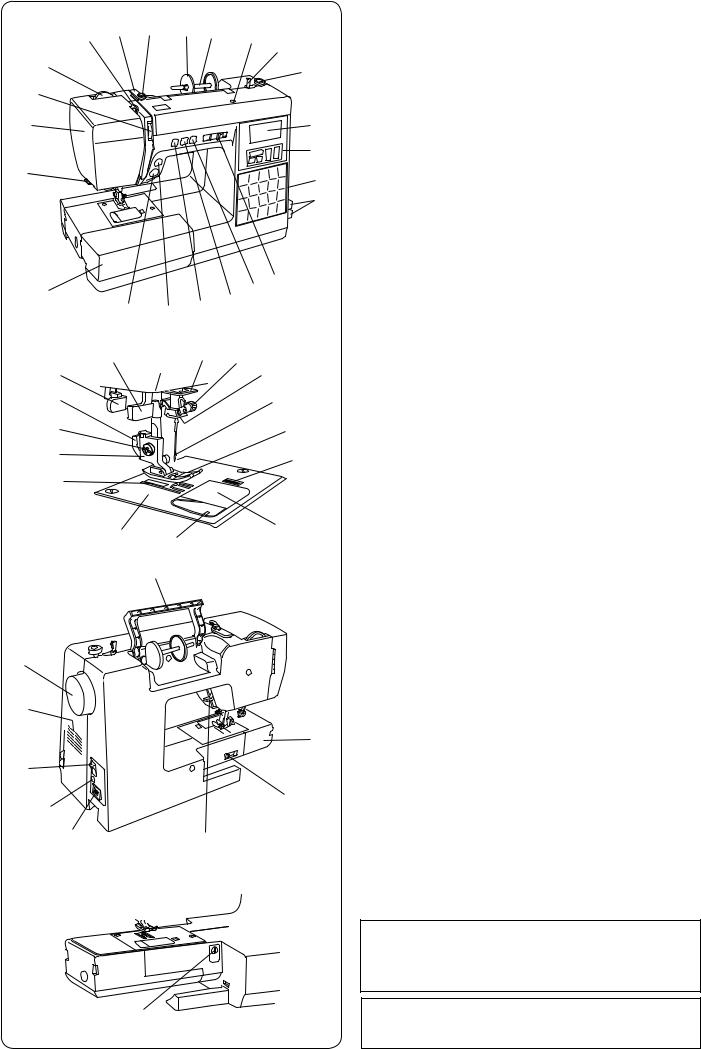
@3 |
q w |
e r |
t y |
|
|
||
|
|
|
|
@2 |
|
|
u |
|
|
|
|
@1 |
|
|
|
@0 |
|
|
i |
|
|
|
o |
!9 |
|
|
!0 |
|
|
|
|
|
|
|
!1 |
!8 |
!3!2 |
|
!7 |
!6 !5 !4 |
|
#8 |
@4 @5 |
|
#7 |
@6 |
|
#6 |
@7 |
|
#5 |
@8 |
|
#4 |
@9 |
|
|
||
#3 |
|
|
#2 |
#0 |
|
#1 |
||
|
||
#9 |
||
$7
$6
$0
$5
$1
$4 $3 $2
$8
ESSENTIAL PARTS
Names of Parts
q Upper thread guide
w Bobbin winding tension disk e Spool holder (large)
r Spool pin
t Hole for extra spool pin y Bobbin winder spindle u Bobbin winder stopper i LCD display
o Function keys
!0Direct stitch selection keys
!1Stitch reference chart !2Speed control slider
!3Automatic thread cutter button !4Needle up/down button !5Auto-lock button
!6Reverse button
!7Start/stop button
!8Extension table (Accessory storage) !9Thread cutter
@0Face cover @1Thread tension dial
@2Presser foot pressure dial @3Thread take-up lever @4Lower thread guide @5Needle clamp screw @6Needle bar thread guide @7Needle
@8Presser foot
@9Hook cover release button #0Hook cover plate #1Thread cutter
#2Needle plate #3Feed dogs #4Foot holder
#5Setscrew
#6Lever #7Buttonhole lever #8Needle threader #9Carrying handle $0Free-arm $1Drop feed lever $2Presser foot lifter $3Power inlet $4Foot control jack $5Power switch
$6Ventilation openings $7Handwheel $8Feed balancing dial
NOTE:
To carry the sewing machine, hold the carrying handle with your hand, and support the sewing machine with the other hand.
NOTE:
Design and specifications are subject to change without prior notice.
3
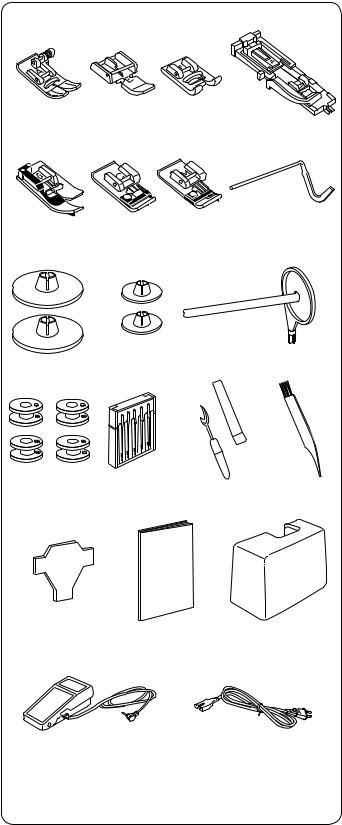
q |
w |
e |
r |
t |
y |
u |
i |
o |
!0 |
|
!1 |
!2 |
!3 |
!4 |
!5 |
!6 |
!7 |
|
!8 |
!9 |
|
|
@0 |
Standard Accessories
No. |
Part Name |
Part No. |
||
1 |
Zigzag foot A (Set on the machine) |
832523007 |
||
2 |
Zipper foot E |
|
808852003 |
|
3 |
Satin stitch foot F |
|
822804118 |
|
4 |
Automatic buttonhole foot R |
753801004 |
||
(stored in the accessory storage) |
||||
5 |
Blind hemming foot G |
825817009 |
||
6 |
Overedge foot C |
|
822801001 |
|
7 |
Overcast foot M |
|
822808008 |
|
8 |
Quilting guide bar |
|
802422002 |
|
9 |
Spool holder (large) X 2 (1 set on the |
822020503 |
||
machine) |
|
|||
10 |
Spool holder (small) X 2 |
822019509 |
||
11 |
Extra spool pin |
|
809146000 |
|
12 |
Bobbin X 4 (1 set on the machine) |
102261103 |
||
13 |
Assorted needle set |
540401026 |
||
14 |
Seam ripper (Buttonhole opener) |
647808009 |
||
15 |
Lint brush |
|
802424004 |
|
16 |
Screwdriver |
|
653802002 |
|
17 |
Instruction book |
|
814800201 |
|
18 |
Hard cover |
|
404701404 |
|
19 |
Foot control |
|
C-1036 |
|
|
|
|
U.S.A and Canada |
856519004 |
20 |
Power cable* |
|
U.K. |
830377008 |
|
Australia |
830314018 |
||
|
|
|
||
|
|
|
Continental Europe |
830335004 |
*The power cable included may differ from the illustration.
4
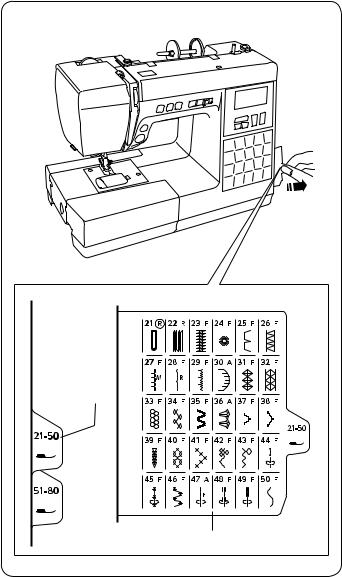
Stitch Reference Chart
Stitch reference charts are stored in the right side of the sewing machine.
The number on each tab indicates the stitch pattern numbers.
Refer to the reference chart you want by pulling the tab all the way to the right.
q Stitch pattern numbers
w Identification letter of the recommended foot e Stitch reference chart
 w
w
q
e
5
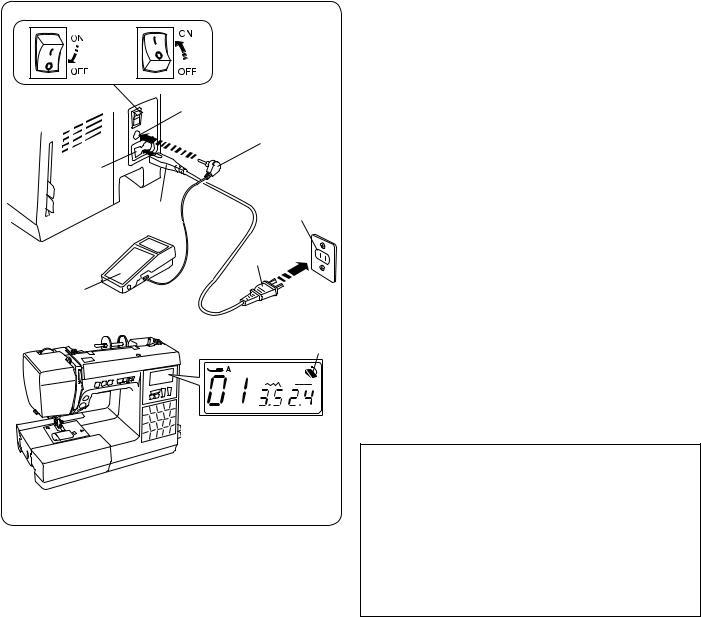
|
|
GETTING READY TO SEW |
q |
|
Connecting the Power Supply |
|
|
Using the foot control |
|
|
Turn off the power switch. |
|
|
Insert the pin connector into the jack. |
|
e |
Insert the machine plug into the power inlet. |
|
Insert the power supply plug into the wall outlet. |
|
|
w |
Turn on the power switch. |
|
q Power switch |
|
|
|
|
t |
|
w Pin connector |
|
|
e Jack |
r |
|
r Machine plug |
u |
t Power inlet |
|
|
|
y Power supply plug |
|
|
u Wall outlet |
|
y |
i Foot control |
|
|
The foot control sign will be displayed when the foot |
i |
|
control is connected to the machine. |
|
|
o Foot control sign |
o
 WARNING:
WARNING:
While in operation, always keep your eyes on the sewing area and do not touch any moving parts such as the thread take-up lever, handwheel or needle. Always turn off the power switch and unplug from the power supply:
-when leaving the machine unattended.
-when attaching or removing parts.
-when cleaning the machine.
Do not place anything on the foot control.
Before Using Your Sewing Machine
Before using your sewing machine for the first time, place a scrap of fabric under the presser foot and run the machine without thread for a few minutes. Wipe away any oil which may appear.
Operating Instructions:
The symbol “O” on the switch indicates the “off” position of the switch.
Foot control model YC-485EC-1 is used with this sewing machine.
For the U.S.A and Canada only:
For appliances with a polarized plug (one blade wider than the other): To reduce the risk of electric shock, this plug is intended to fit in a polarized outlet only one way. If it still does not fit, contact a qualified electrician to install the proper outlet. Do not modify the plug in any way.
6
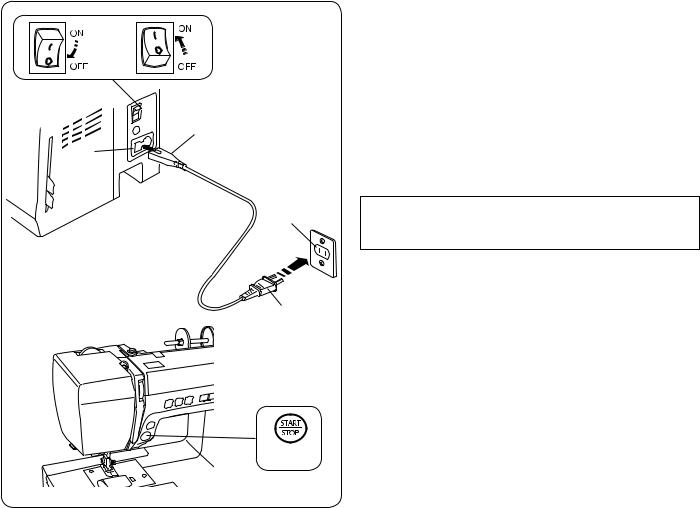
|
Using the start/stop button |
|
q |
Turn off the power switch. |
|
|
Insert the machine plug into the power inlet. |
|
|
Insert the power supply plug into the wall outlet. |
|
|
Turn on the power switch. |
|
|
q Power switch |
|
|
w Machine plug |
|
w |
e Power inlet |
|
e |
r Power supply plug |
|
t Wall outlet |
||
|
||
|
y Start/Stop button |
NOTE:
tThe start/stop button does not work when the foot control is connected.
r
y
7
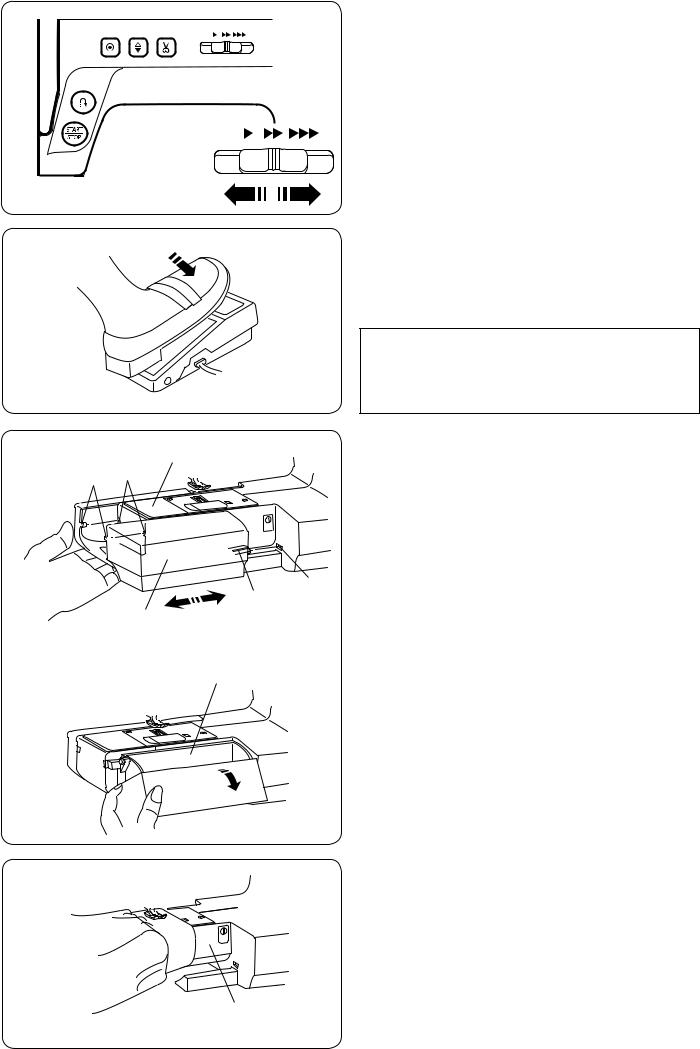
w
e r
Controlling Sewing Speed
Speed control slider
Sewing speed can be varied by the speed control slider according to your sewing needs.
To increase sewing speed, move the slider to the right. To decrease sewing speed, move the slider to the left.
Foot control
Depress the foot control to start the machine.
The further down you press on the foot control, the faster the machine runs.
The maximum sewing speed can be varied by the speed control slider.
NOTE:
The machine will not run and the presser foot mark will blink if you start the machine with the presser foot in the up position. Lower the presser foot and press the foot control.
Extension Table
The extension table provides an extended sewing area and can be easily removed for free-arm sewing.
Detaching the table
Pull the table away from the machine, as illustrated. q Extension table
Attaching the table
rSlide the extension table along the free-arm and insert
e |
the guides into the holes until the table snaps into the |
q |
machine. |
|
w Free-arm |
|
e Guide |
|
r Hole |
t
Accessory storage
Accessories are stored inside the extension table.
Pull the lid toward you to open the accessory storage t. t Accessory storage
Free-arm Sewing
Free-arm is useful for sewing tubular garments and for darning knee or elbow areas.
q Free-arm
q
8
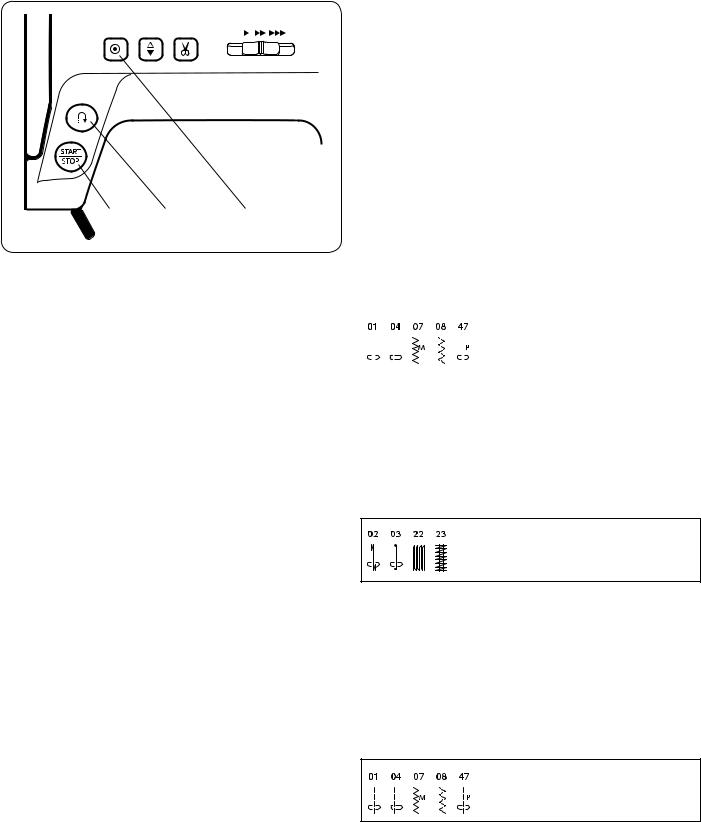
|
|
|
|
Machine Operating Buttons |
|||
|
|
|
|
q Start/Stop button |
|||
|
|
|
|
Press this button to start or stop the machine. |
|||
|
|
|
|
The machine starts running slowly for the first few |
|||
|
|
|
|
stitches, and it then runs at the speed set by the speed |
|||
|
|
|
|
control slider. |
|||
|
|
|
|
The machine runs slowly as long as this button is being |
|||
|
|
|
|
pressed. |
|||
|
|
|
|
NOTE: |
|||
|
|
|
|
• The start/stop button cannot be used when the foot |
|||
|
|
|
|
|
control is connected to the machine. |
||
|
|
|
|
• The machine will not run and the presser foot mark |
|||
q |
w |
e |
|
|
will blink if you start the machine with the presser |
||
|
|
|
|
|
foot in the up position. Lower the presser foot and |
||
|
|
|
|
|
press the start/stop button. |
||
|
|
|
|
w Reverse button |
|||
|
|
|
|
• When following stitch patterns are selected; |
|||
|
|
|
|
|
|
|
|
|
|
|
|
|
|
|
|
|
|
|
|
|
|
|
|
|
|
|
|
|
|
|
|
|
|
|
|
|
|
|
|
|
|
|
|
|
|
|
|
|
|
|
|
|
|
|
|
|
|
|
|
|
|
|
|
|
|
|
|
|
|
|
|
The machine will sew in reverse as long as the reverse button is pressed. Release the button to sew forward.
When the machine is stopped and foot control is disconnected, the machine will sew in reverse slowly as long as the reverse button is pressed. Release the button to stop the machine.
• When following stitch patterns are selected;
There will be particular functions of the reverse button when patterns shown above are selected. Refer to pages 30, 41 and 42 for instructions.
•When any other stitches are selected;
If you press the reverse button when sewing any other patterns, the machine will immediately sew locking stitches and automatically stop.
e Auto-lock button
• When following stitch patterns are selected;
Press the auto-lock button to sew a locking stitch immediately. The machine will automatically stop.
•When any other stitches are selected;
Press the auto-lock button to sew a locking stitch at the end of current pattern. The machine will automatically stop.
9
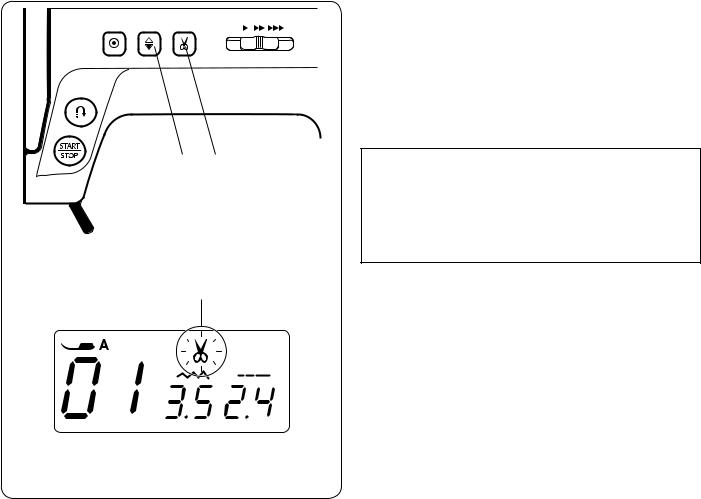
r t
y
r Needle up/down button
Press the needle up/down button to bring the needle up or down.
t Thread cutter button
Press the thread cutter button to trim the threads after sewing.
The thread cutter mark will blink y while the machine cuts the threads.
NOTE:
The thread cutter button does not function:
-directly after turning on the power.
-when the presser foot is raised.
-after being pressed 3 times in a row.
Use the thread cutter on the face plate if the thread is #30 or thicker (refer to page 26 ).
10

q e r
w

w e
q


r


 t
t
y
LCD Display
NOTE:
Magnetic or electrostatic interference may cause the LCD display to flicker.
Do not use the machine near appliances that generate a magnetic field or an electrostatic field such as microwave ovens.
The LCD display shows following information when the machine is turned on.
q Identification letter of the recommended foot w Stitch pattern number
e Stitch width r Stitch length
Function Keys q Arrow key
Press “ ” or “
” or “  ” to select the stitch pattern. Refer to page 12.
” to select the stitch pattern. Refer to page 12.
w Stitch width adjusting key
Press “+” or “–” to change the stitch width or needle drop position, depending on the selected stitch pattern. Refer to pages 29, 32 and 38.
e Stitch length adjusting key
Press “+” or “–” to change the stitch length of the selected pattern. You can also adjust the buttonhole density, the evenness of darning, and the size of eyelet with this key. Refer to pages 29, 32 and 38.
r Thread cutter memory key
To cut the threads automatically after locking stitches, press the thread cutter memory key.
Refer to page 27.
t Elongation key
Press this key to elongate satin stitch patterns. Refer to page 57.
y Direct pattern selection keys
You can select the stitch patterns from 01 to 20 directly by pressing the corresponding keys.
Refer to page 12.
11
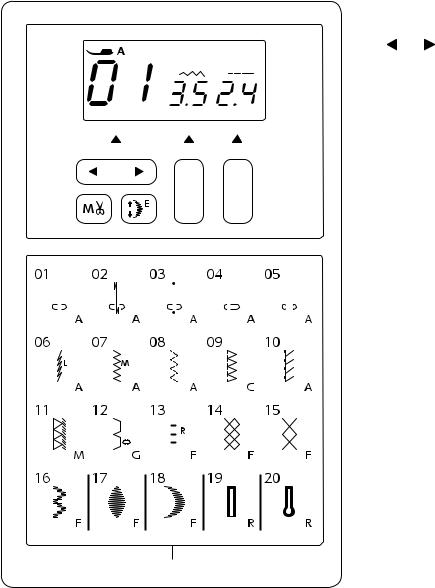
Selecting Stitch Patterns
To select the desired stitch pattern, press the arrow key
|
|
|
|
|
|
|
|
|
|
|
|
|
|
|
|
|
|
|
|
|
|
|
|
|
|
|
|
q ( |
or |
) until the pattern number of the desired |
|
|
|
|
|
|
|
|
|
|
|
|
|
|
|
|
|
|
|
|
|
|
|
|
|
|
|
|
stitch is indicated w. |
||
|
|
|
|
|
|
|
|
|
|
|
|
|
|
|
|
|
|
|
|
|
|
|
|
|
|
|
|
|||
w |
|
|
|
|
|
|
|
|
|
|
|
|
|
|
|
|
|
|
|
|
|
|
|
|
|
|
|
To refer available stitch patterns for this sewing machine, |
||
|
|
|
|
|
|
|
|
|
|
|
|
|
|
|
|
|
|
|
check the stitch reference chart stored in the right side of |
|||||||||||
|
|
|
|
|
|
|
|
|
|
|
|
|
|
|
|
|
|
|
|
|
|
|
|
|
|
|
|
|||
|
|
|
|
|
|
|
|
|
|
|
|
|
|
|
|
|
|
|
|
|
|
|
|
|
|
|
|
the sewing machine or the stitch chart in this manual on |
||
|
|
|
|
|
|
|
|
|
|
|
|
|
|
|
|
|
|
|
|
|
|
|
|
|
|
|
|
|||
|
|
|
|
|
|
|
|
|
|
|
|
|
|
|
|
|
|
|
|
|
|
|
|
|
|
|
|
page 63. |
|
|
|
|
|
|
|
|
|
|
|
|
|
|
|
|
|
|
|
|
|
|
|
|
|
|
|
|
|
|
Direct pattern selection |
||
q |
|
|
|
|
|
|
|
|
|
|
|
|
|
|
|
|
|
|
|
|
|
|
|
|
|
You can select stitch patterns 01 to 20 directly by |
||||
|
|
|
|
|
|
|
|
|
|
|
|
|
|
|
|
|
|
|
|
|
|
|
||||||||
|
|
|
|
|
|
|
|
|
|
|
|
|
|
|
|
|
|
|
|
|
|
|
|
|
|
|
|
pressing the corresponding direct pattern selection key e. |
||
|
|
|
|
|
|
|
|
|
|
|
|
|
|
|
|
|
|
|
|
|
|
|
|
|
|
|
|
|||
|
|
|
|
|
|
|
|
|
|
|
|
|
|
|
|
|
|
|
|
|
|
|
|
|
|
|
|
The stitch image of stitch pattern are indicated on each |
||
|
|
|
|
|
|
|
|
|
|
|
|
|
|
|
|
|
|
|
|
|
|
|
|
|
|
|
|
key. |
|
|
|
|
|
|
|
|
|
|
|
|
|
|
|
|
|
|
|
|
|
|
|
|
|
|
|
|
|
|
|
|
|
|
|
|
|
|
|
|
|
|
|
|
|
|
|
|
|
|
|
|
|
|
|
|
|
|
|
|
|
|
|
|
|
|
|
|
|
|
|
|
|
|
|
|
|
|
|
|
|
|
|
|
|
|
|
|
|
|
|
|
|
|
|
|
|
|
|
|
|
|
|
|
|
|
|
|
|
|
|
|
|
|
|
|
|
|
|
|
|
|
|
|
|
|
|
|
|
|
|
|
|
|
|
|
|
|
|
|
|
|
|
|
|
|
|
|
|
|
|
|
|
|
|
|
|
|
|
|
|
|
|
|
|
|
|
|
|
|
|
|
|
|
|
|
|
|
|
|
|
|
|
|
|
|
|
|
|
|
|
|
|
|
|
|
|
|
|
|
|
|
|
|
|
|
|
|
|
|
|
|
|
|
|
|
|
|
|
|
|
|
|
|
|
|
|
|
|
|
|
|
|
|
|
|
|
|
|
|
|
|
|
|
|
|
|
|
|
|
|
|
|
|
|
|
|
|
|
|
|
|
|
|
|
|
|
|
|
|
|
|
|
|
|
|
|
|
|
|
|
|
|
|
|
|
|
|
|
|
|
|
|
|
|
|
|
|
|
|
|
|
|
|
|
|
|
|
|
|
|
|
|
|
|
|
|
|
|
|
|
|
|
|
|
|
|
|
|
|
|
|
|
|
|
|
|
|
|
|
|
|
|
|
|
|
|
|
|
|
|
|
|
|
|
|
|
|
|
|
|
|
|
|
|
|
|
|
|
|
|
|
|
|
|
|
|
|
|
|
|
|
|
|
|
|
|
|
|
|
|
|
|
|
|
|
|
|
|
|
|
|
|
|
|
|
|
|
|
|
|
|
|
|
|
|
|
|
|
|
|
|
|
|
|
|
|
|
|
|
|
|
|
|
|
|
|
|
|
|
|
|
|
|
|
|
|
|
|
|
|
|
|
|
|
|
|
|
|
|
|
|
|
|
|
|
|
|
|
|
|
|
|
|
|
|
|
|
|
|
|
|
|
|
|
|
|
|
|
|
|
|
|
|
|
|
|
|
|
|
|
|
|
|
|
|
|
|
|
|
|
|
|
|
|
|
|
|
|
|
|
|
|
|
|
|
|
|
|
|
|
|
|
|
|
|
|
|
|
|
|
|
|
|
|
|
|
|
|
|
|
|
|
|
|
|
|
|
|
|
|
|
|
|
|
|
|
|
|
|
|
|
|
|
|
|
|
|
|
|
|
|
|
|
|
|
|
|
|
|
|
|
|
|
|
|
|
|
|
|
|
|
|
|
|
|
|
|
|
|
|
|
|
|
|
|
|
|
|
|
|
|
|
|
|
|
|
|
|
|
|
|
|
|
|
|
|
|
|
|
|
|
|
|
|
|
|
|
|
|
|
|
|
|
|
|
|
|
|
|
|
|
|
|
|
|
|
|
|
|
|
|
|
|
|
|
|
|
|
|
|
|
|
|
|
|
|
|
|
|
|
|
|
|
|
|
|
|
|
|
|
|
|
|
|
|
|
|
|
|
|
|
|
|
|
|
|
|
|
|
|
|
|
|
|
|
|
|
|
|
|
|
|
|
|
|
|
|
|
|
|
|
|
|
|
|
|
|
|
|
|
|
|
|
|
|
|
|
|
|
|
|
|
|
|
|
|
|
|
|
|
|
|
|
|
|
|
e
12
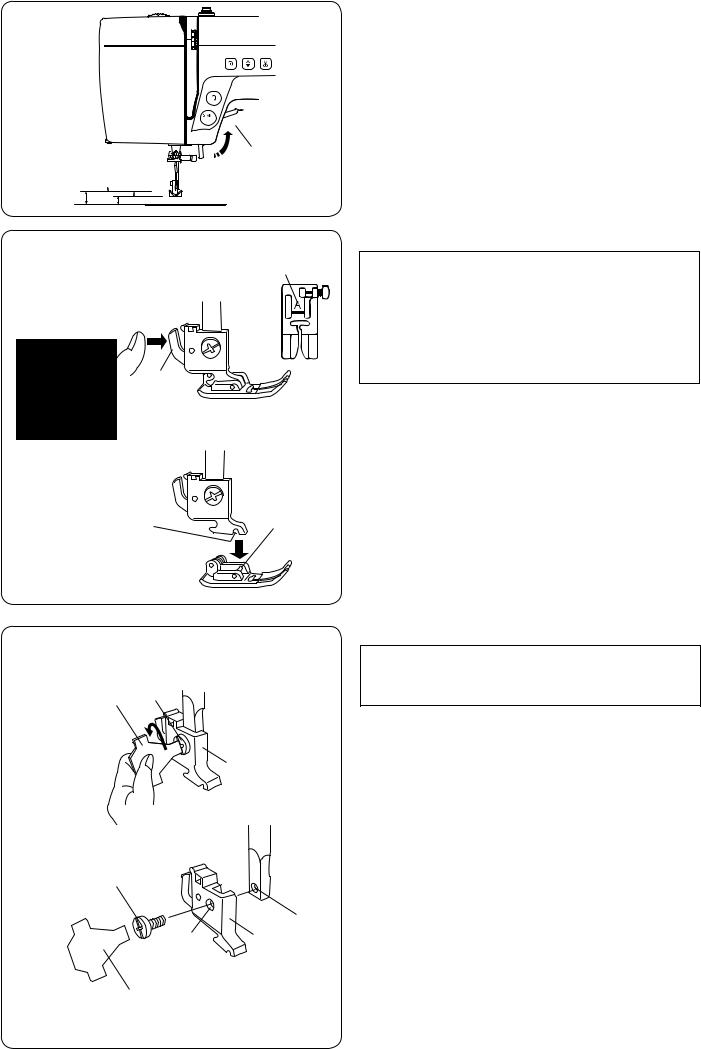
e w
w
e
eq
q

 e
e 

 w
w
q
q
r
w
t
rw
e
Presser Foot Lifter
The presser foot lifter raises and lowers the presser foot.
You can raise the foot about 1/4˝ (0.7 cm) higher than the normal up position for easy removal of the presser foot, or to help you place thick material under the foot.
q Presser foot lifter w Normal up position e Highest position
Changing the Presser Foot
 CAUTION:
CAUTION:
•Turn OFF the power switch before changing the foot.
•Always use the proper foot for the selected pattern.
The wrong foot can cause the needle to break.
Each foot is marked with an identification letter. q Identification letter
Removing the presser foot
Raise the needle to its highest position by turning the handwheel counterclockwise. Raise the presser foot, and press the lever on the back of the foot holder.
w Lever
Attaching the presser foot
Place the selected presser foot so that the pin on the foot lies just under the groove in the foot holder.
Lower the presser bar to lock the foot into the place. e Groove
r Pin
Removing and Attaching the Foot Holder
 CAUTION:
CAUTION:
Turn OFF the power switch before detaching or attaching foot holder.
Removing the foot holder
Remove the setscrew by turning it counterclockwise with a screwdriver.
q Setscrew w Foot holder e Screwdriver
Attaching the foot holder
Align the hole in the foot holder with the threaded hole in the presser bar.
Fit the setscrew into the hole.
Tighten the setscrew by turning it clockwise with the screwdriver.
r Hole
t Threaded hole
13

|
Presser Foot Pressure Dial |
|
|
Foot pressure can be adjusted by turning the presser foot |
|
q |
pressure dial. |
|
Set the pressure between “3” and “6” for ordinary fabrics. |
||
|
||
|
Set the pressure between “1” and “3” for fine fabrics and |
|
|
applique sewing. |
|
|
Set the pressure between “5” and “6” for heavyweight |
|
|
fabrics. |
|
|
q Presser foot pressure dial |
|
Adjusting the Needle Thread Tension |
|
Straight stitch balanced tension |
q |
The ideal straight stitch has threads locked between two |
|
layers of fabric, as illustrated (magnified to show detail). |
|
If you look at the top and bottom of the seam, notice that |
|
the stitches are evenly balanced. |
|
q Needle thread (top thread) |
|
w Bobbin thread (bottom thread) |
|
e To loosen |
w |
r To tighten |
|
When adjusting the needle thread tension, the higher the |
|
number, the tighter the top thread tension. |
e |
Results depend on: |
|
- stiffness and thickness of the fabric |
r |
- number of fabric layers |
|
- type of stitch |
r |
t |
Tension is too tight |
|
The bobbin thread shows through on the right side of the |
|||
q |
|
||
|
fabric, and the stitch feels bumpy. Turn the dial to a lower |
||
|
|
||
|
|
number to loosen the needle thread tension. |
|
|
|
q Needle thread (top thread) |
|
|
|
w Bobbin thread (bottom thread) |
|
|
|
e To loosen tension |
|
w |
|
r Right side (top side) of fabric |
|
|
e |
t Wrong side (bottom side) of fabric |
|
|
|
|
Tension is too loose |
t |
The needle thread shows through on the wrong side of |
r |
the fabric, and the stitch feels bumpy. Turn the dial to a |
q |
higher number to tighten the needle thread tension. |
|
q Needle thread (top thread) |
|
w Bobbin thread (bottom thread) |
|
e To tighten tension |
w |
r Right side (top side) of fabric |
|
t Wrong side (bottom side) of fabric |
e |
|
14
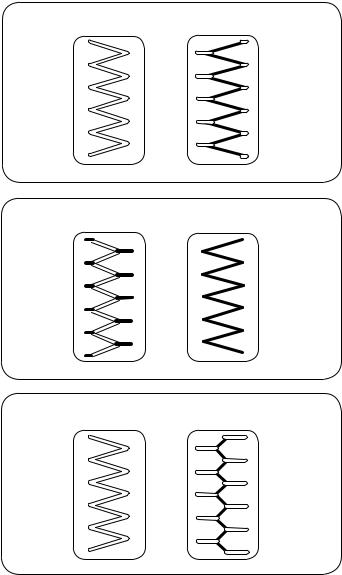
Zigzag stitch balanced tension
For an ideal zigzag stitch, the bobbin thread does not show on the right side (top side) of the fabric, and the needle thread shows slightly on the wrong side (bottom side) of the fabric.
See the illustrations for the correct appearance.
To match this appearance, adjust the needle tension as necessary.
q |
w |
Balanced tension |
|
Minimize the amount of needle thread visible on the |
|||
|
|
||
|
|
wrong side (bottom side) of the fabric without causing |
|
|
|
excessive puckering, or causing the bobbin thread to |
|
|
|
show on the right side (top side) of the fabric. |
|
|
|
Results vary with fabric, thread and sewing conditions. |
|
|
|
q Right side (top side) of fabric |
|
|
|
w Wrong side (bottom side) of fabric |
q |
w |
Tension is too tight |
|
The corner of each zigzag pulls together on the right side |
|||
|
|
||
|
|
of the fabric |
|
|
|
q Right side (top side) of fabric |
|
|
|
w Wrong side (bottom side) of fabric |
q |
w |
Tension is too loose |
|
The corner of each zigzag point pulls together on the |
|||
|
|
||
|
|
wrong side of the fabric. |
|
|
|
q Right side (top side) of fabric |
|
|
|
w Wrong side (bottom side) of fabric |
15
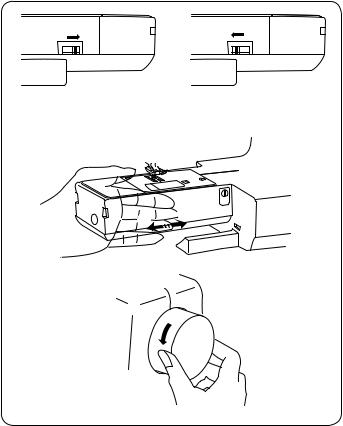
q w
View from the rear
q  w
w
Dropping or Raising the Feed Dog
The drop feed lever is located underneath the free arm bed on the back of the machine.
To drop the feed dog, push the lever in the direction of the arrow q.
To raise the feed dog, push the lever in the direction of the arrow w, as illustrated, and turn the handwheel toward you.
The feed dog must be up for normal sewing.
16
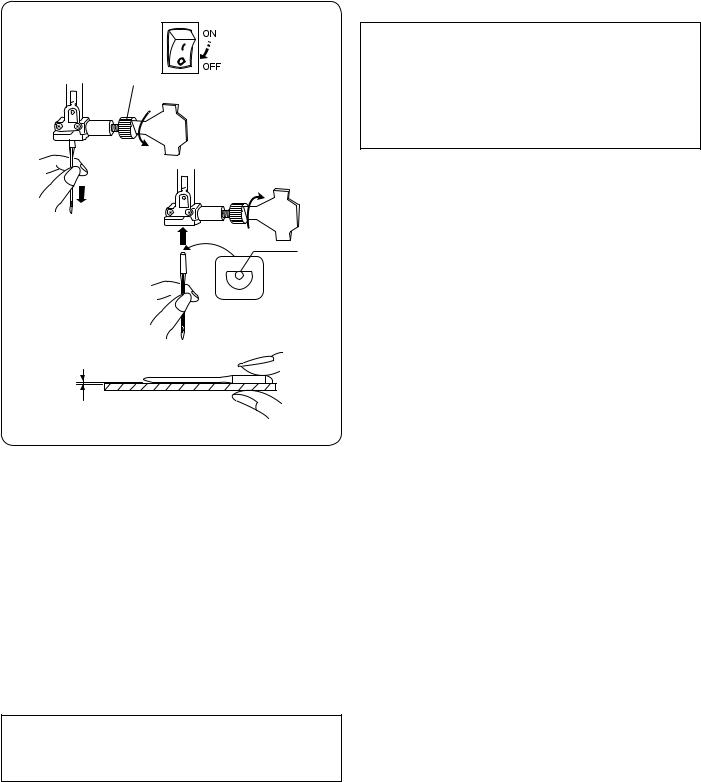
q
w
Fabric |
Thread |
Needle |
||
|
Lawn |
|
|
|
|
Georgette |
Silk #80-100 |
#9/65-11/75 |
|
Fine |
Tricot |
Cotton #80-100 |
||
Blue tip needle |
||||
|
Organza |
Synthetic #80-100 |
||
|
Crepe |
|
|
|
|
Sheeting |
Silk #50 |
|
|
Medium |
Jersey |
Cotton #50-80 |
#11/75-14/90 |
|
|
Broadcloth |
Synthetic #50-80 |
|
|
|
Fleece |
|
|
|
|
Denim |
Silk #30-50 |
|
|
Heavy |
Tweed |
|
||
Cotton #40-50 |
#14/90-16/100 |
|||
weight |
Coating |
|||
Synthetic #40-50 |
|
|||
|
Quilting |
|
||
|
|
|
||
NOTE:
1 x blue tip needle (#11/75), 2 x #11/75 needles and 2 x #14/90 needles are included in the needle case (Part No. 540401026).
Changing the Needle
 CAUTION:
CAUTION:
Turn OFF the power switch before changing the needle.
Raise the needle to its highest position by turning the handwheel counterclockwise.
A loose needle or a loose screw may cause machine malfunction or needle to break.
Loosen the needle clamp screw by turning it counterclockwise. Remove the needle from the needle clamp.
Insert a new needle into the needle clamp with the flat side to the rear. When inserting the needle into the needle clamp, push it up as far as it will go.
Tighten the needle clamp screw firmly by turning it clockwise.
q Needle clamp screw w Flat side
To see if the needle is in good condition, place the flat side of the needle onto something flat (needle plate, glass etc.). The gap between the needle and the flat surface should be consistent. Never use a bent or blunt needle. A damaged needle can cause permanent snags or runs in knits, fine silks and silk-like fabrics.
Fabric, Thread and Needle Chart
•For general sewing, use needle size 11/75 or 14/90.
•A fine thread and needle should be used for sewing lightweight fabrics, so the fabric will not be marred.
•Heavy fabrics require a needle large enough to pierce the fabric without fraying the needle thread.
•Always test the needle size on a small scrap of the fabric that will be used for actual sewing.
•In general, use the same thread for the needle and bobbin.
•When sewing stretch fabrics, very fine fabrics and synthetics, use a blue tip needle. The blue tip needle effectively prevents skipped stitches.
17
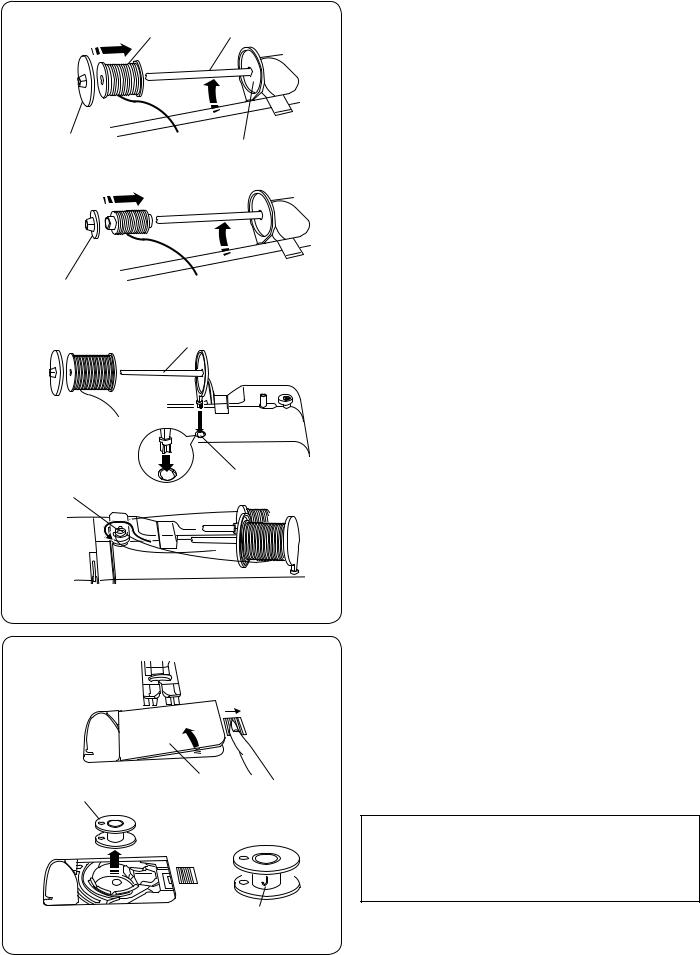
wq
er
t
y
u
i
q
w
e
r
Setting the Spool of Thread
Horizontal spool pin
Lift up the spool pin. Place a spool of thread on the spool pin.
Attach the large spool holder, and press it firmly against the spool of thread so that the spool rests on the supporter.
q Spool pin
w Spool of thread e Large spool holder r Supporter
The small spool holder is used with narrow or small spools of thread.
t Small spool holder
Extra spool pin
The extra spool pin is for winding bobbins without unthreading the machine.
Insert the extra spool pin into the hole.
The extra spool pin should point to the bobbin winder tension disk.
Draw the thread from the spool and pass the thread around the bobbin winding tension disk as shown.
y Extra spool pin
u Hole for extra spool pin
i Bobbin winder tension disk
Bobbin Winding
Removing the bobbin
Gently slide the hook cover release button to the right and remove the hook cover plate.
Lift out the bobbin.
q Hook cover release button w Hook cover plate
e Bobbin
NOTE:
Use the “J” plastic bobbins for horizontal hook (marked with “J” r). Using other bobbins, such as pre-wound paper bobbins, may cause stitching problems and/ or damage to the bobbin holder.
18
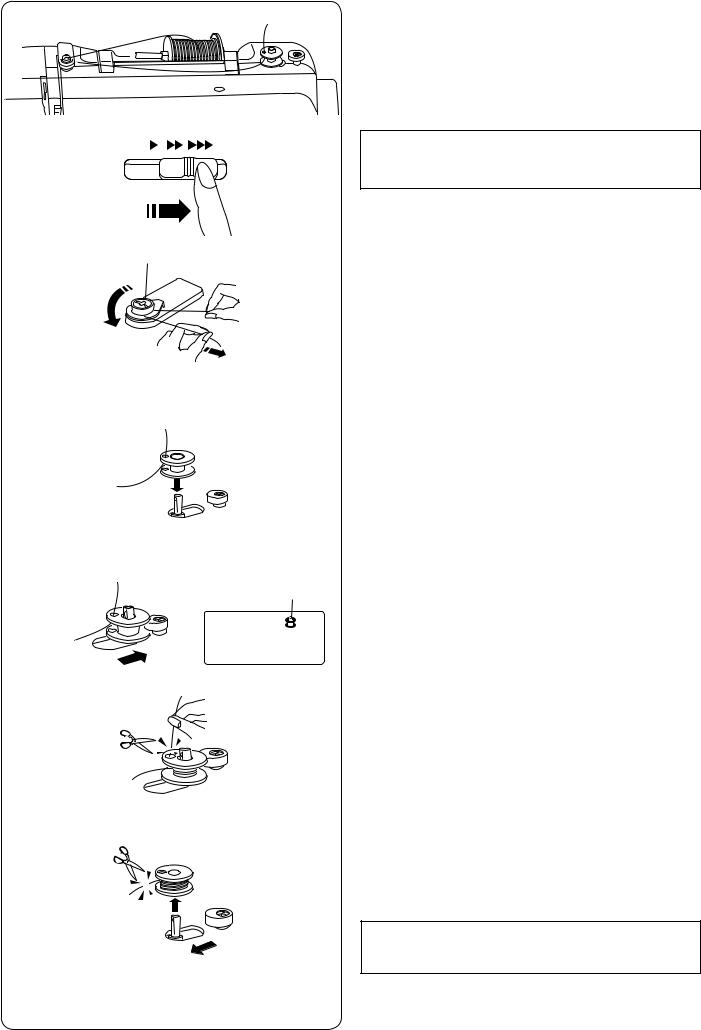
Winding the bobbin
NOTE:
Set the speed control slider at its fastest position for bobbin winding.
|
q |
z |
z Draw the thread from the spool and pass the thread |
|
around the bobbin winding tension disk. |
|
q Bobbin winding tension disk |
x c |
x Thread through the hole in the bobbin from the inside |
|
to the outside. |
|
c Put the bobbin on the bobbin winder spindle. |
v |
|
v Push the bobbin to the right. |
|
w |
The bobbin icon appears on the LCD display. |
|
|
w Bobbin icon |
b |
b With the free end of the thread held in your hand, start |
|
the machine. Stop the machine when it has wound a |
|
few layers, and then cut the thread close to the hole in |
|
the bobbin. |
n m |
n Start the machine. When the bobbin is fully wound, it |
|
|
|
will stop spinning automatically. |
|
Stop the machine and return the bobbin winder to its |
|
original position by moving the spindle to the left. |
NOTE:
Do not move the bobbin winder spindle while the machine is running.
m Remove the bobbin. Cut the thread as shown. Return the speed control slider position.
19
